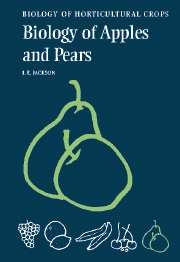Book contents
- Frontmatter
- Contents
- Preface
- Acknowledgements
- Introduction
- 1 The growing of apples and pears
- 2 Apples and pears and their relatives
- 3 Apple and pear root systems: induction, development, structure and function
- 4 The graft union, grafting and budding
- 5 Mechanisms of rootstock and interstock effects on scion vigour
- 6 The shoot system
- 7 Leaves, canopies and light interception
- 8 Photosynthesis, respiration, and carbohydrate transport, partitioning and storage
- 9 Flowers and fruits
- 10 Eating quality and its retention
- 11 Mineral nutrition
- 12 Water relations
- 13 Diseases, pests, and resistance to these
- 14 Biotechnology of apples and pears
- Cultivar Index
- General Index
- References
7 - Leaves, canopies and light interception
Published online by Cambridge University Press: 13 August 2009
- Frontmatter
- Contents
- Preface
- Acknowledgements
- Introduction
- 1 The growing of apples and pears
- 2 Apples and pears and their relatives
- 3 Apple and pear root systems: induction, development, structure and function
- 4 The graft union, grafting and budding
- 5 Mechanisms of rootstock and interstock effects on scion vigour
- 6 The shoot system
- 7 Leaves, canopies and light interception
- 8 Photosynthesis, respiration, and carbohydrate transport, partitioning and storage
- 9 Flowers and fruits
- 10 Eating quality and its retention
- 11 Mineral nutrition
- 12 Water relations
- 13 Diseases, pests, and resistance to these
- 14 Biotechnology of apples and pears
- Cultivar Index
- General Index
- References
Summary
Leaf anatomy and morphology
Leaf primordia are initiated by periclinal divisions in layers 2 or 3 of the tunica on the flanks of apical meristems (Pratt, 1990). They develop into protuberances flattened on the adaxial side. The base of the leaf primordium is an intercalary meristem and forms the petiole. The leaf blade develops concomitantly from two layers of cells derived from marginal and sub-marginal initials which produce a marginal meristem on the lateral flanks of the midrib. The superficial cells of the marginal meristems divide anticlinally to form epidermal cells. The sub-epidermal cells on the adaxial (upper) side become the first row of palisade cells and those of the abaxial side form the spongy mesophyll. Cells between these two layers form the central mesophyll and the smaller vascular bundles. On the adaxial side sub-epidermal and central meristematic cells differentiate into one to three or more layers of palisade cells depending on leaf type and environmental conditions. Each mature palisade cell is surrounded by air space continuous with that in the spongy mesophyll, except in the vicinity of a vein.
At maturity (Figure 7.1) the adaxial cuticle consists of a layer of wax and cutin. The abaxial epidermal cells have thinner cuticles than the adaxial ones. They are variable in thickness and shape except for the paired, kidney-shaped guard cells which are nearly constant in size within a cultivar and surround the pores or stomates through which gas exchange with the external air takes place.
- Type
- Chapter
- Information
- The Biology of Apples and Pears , pp. 210 - 236Publisher: Cambridge University PressPrint publication year: 2003
References
- 1
- Cited by



